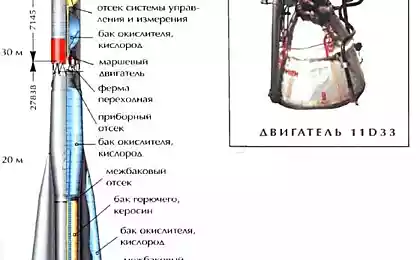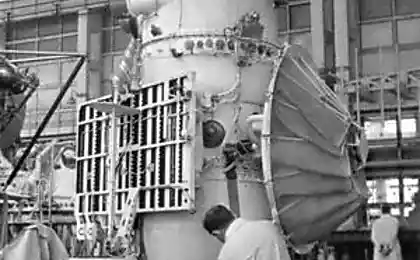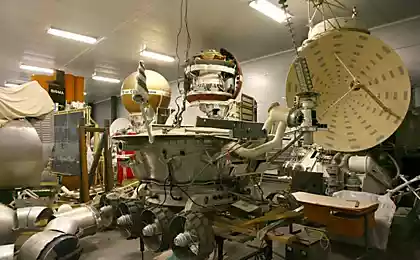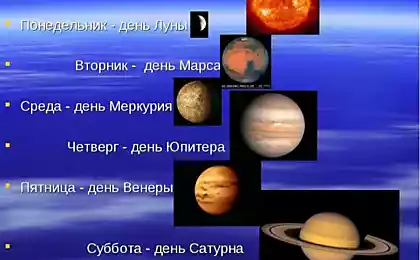1314
Morning goddess of beauty with a heavy character
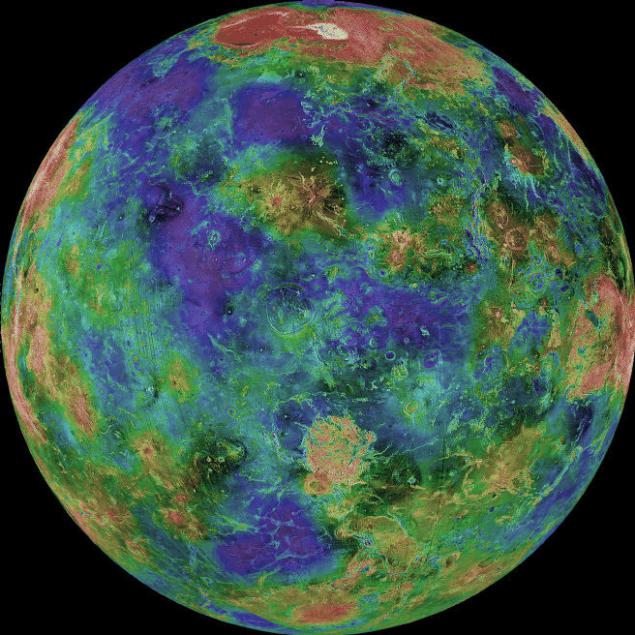
Good night, Giktayms. Today we decided to recall an important event that took place exactly 47 years ago, October 18, 1967. On this day, the interplanetary station "Venera-4" for the first time in history managed to carry out direct measurements of the atmosphere of another planet and send them to Earth.
As suggested by Captain Obviously, this was not the first unit sent to study the second planet of the solar system. Before there were the span "Venus-1" and "Venera-2" and landing "Venera-3". But because of the loss of control before approaching the station broke the planet.
On the fourth "Venus" was more fortunate. After entering the atmosphere cleanly separated descent module and the orbital part of the Earth continued to transmit telemetry information until burned in the atmosphere.
Parachute module within 93 minutes had sent information regularly, but the surface is still not reached. At least in general form. The fact that the atmospheric pressure at the surface of Venus is estimated at 10 atmospheres, with engineers put into the design of the landing module double margin of safety. But at the height of 28 km had been crushed. Later it turned out that the calculations were completely wrong, and the pressure at the surface reaches as much as 93 atmospheres. Nevertheless, for the first time in human history able to directly measure the temperature, density, pressure and chemical composition of the atmosphere of another planet.
The descent module had to work for about 100 minutes, it was so fed to the equipment battery is recharged during flight by solar panels. Scientists accurately calculate the surface temperature of the planet is 450 degrees Celsius, subsequent measurements yielded more accurate data - 475 degrees. One of the branches of hell, not otherwise. Due to such a high temperature and atmospheric pressure, a huge, none of the research unit was not able to work on Venus more than two hours.
The Soviet program of research with the help of Venus automatic interplanetary stations still remains unsurpassed for results, the volume of the data and the number of vehicles that have reached the planet and vnёsshih contribution to expanding our knowledge of this red-hot planet (19 pieces). "Venus-1" was launched two months before Yuri Gagarin's flight, and our last unit, participated in the study of the "Morning Star," Vega-2, was launched almost 24 years.
Over the past since almost 30 years in our country and the world has seen a lot of things, and it was not until Venus. Today, our space program is much more modest, and have a higher priority exploration of the Moon and Mars, due to practical considerations only property - as long as it is the most likely candidates to send a manned spacecraft and development. This is not a hell of a gloomy thick carbon-dioxide, which, on its last legs, vysokozaschischёnnye machines worked a few tens of minutes. Yet Venus try not to forget, although a residual, apparently, the principle - "Venera-D", whose descent module will be able to work on the surface for about a year, plans to launch no earlier than 10 years.
Because of the extreme climate Venus is serious interest from the point of view of possible colonization, in contrast to the Moon and Mars. Wernher von Braun, an incredibly talented designer rocketeer, the author of the missile program of the Third Reich, whose gift is bordered on genius, in 1954, predicted that people will be able to arrive at Mars no earlier than the 50s of this century. And judging by the trends, its prognosis may be incredibly accurate. But this is Mars, much easier to master the planet than Venus.
However, even relatively recently that people actively fantasized about this topic, create development projects Venus. For example, it was proposed to bombard capsules stuffed with seaweed, which would multiply and processed carbon dioxide, which consists of the planet's atmosphere.
True, Venus is not a drop of water. Even if you throw at it somehow some huge comets composed of ice, then for almost 500 degrees Celsius water is present exclusively in the form of steam. Many of the ideas of development of Venus operated flying objects that are in a much more favorable conditions in terms of temperature and pressure.
Modern ideas of residential settlements on Venus are much more modest. For example, is such a flying station, located at an altitude of 50 km, between the layers of sulfuric acid clouds and sulfuric acid mist, where the pressure is approximately equal to one atmosphere.
And here's a little video showing experience in diving balloon into carbon dioxide, which is intended to illustrate the idea of the possibility of creating a flying settlements on Venus:
Why? Given the difficulty of sustaining life on Venus, there is a reasonable question: "Why is all you need to persist for what?". There are several reasons.
The first and obvious - the study of the planet. For the atmosphere of Venus is characterized by a number of features that put scientists in a deadlock. In this case, we are not talking about abstract scientific curiosity. Since Venus is very close in size to Earth, the study of the causes and mechanisms of the existence of certain phenomena may help solve some of the problems we have "home". Here are some of the mysteries of the Venusian climate:
- Up to the greenhouse effect, supported the densest atmosphere of carbon dioxide, whether Venus is so hot?
- There Is Venus ever ocean? If so, whether there life? (The water vapor content in the atmosphere is estimated at only 0, 02%)
- What is the cause geological instability planet's surface? It is estimated that the age of the surface is only 500 million years.
- What is the cause of atmospheric superrotation? Almost the entire volume of the atmosphere of Venus is involved in a giant hurricane, that is, all gaseous envelope of the planet is moving in the same direction.
- What is the composition of aerosol particles present in the atmosphere of Venus?
- What is the composition "of snow "on the tops of mountains Venus?
- What causes a chemical imbalance in the atmosphere? In the upper layers of the detected hydrogen sulfide and sulfur dioxide, which without constant source of "make-up" must be a chemical reaction to form other compounds. Moreover, carbonyl sulfide is detected whose synthesis inorganic process very difficult. All this is fueling hopes of scientists to the existence of microorganisms in the upper layers of dense Venusian atmosphere, which are the sources of production of the three above-mentioned gases.
The third reason for the colonization of Venus - gain experience in establishing settlements in extremely adverse conditions. For those times when humanity will be able to go beyond the solar system. But this is the foundation for the very distant future.
Source: geektimes.ru/company/mailru/blog/240402/
Batteries wildebeest: Samsung develops flexible battery for smart watches
A couple from the city of Perm named her newborn son ... Lucifer.
